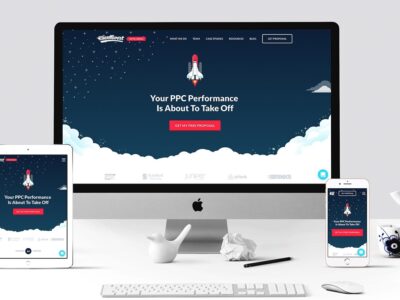Small businesses have one big advantage: they have a lot of growth potential. Without the right strategies, however, success quickly fails due to the budget. Therefore, read in this post how smart marketing for small businesses can be used to attract new customers even in difficult times.
This is how effective marketing for small businesses succeeds
A small budget, little experience, hardly any time: These are probably the most common problems that make small businesses desperate when it comes to marketing. In order to illustrate the tips in this article, we would like to introduce ourselves to Mr. Köhler at this point. He is the owner of a small driving school. He, too, would like to use better marketing strategies to keep his company going for a long time. In doing so, he is faced with the problems just mentioned. The following tips show how he can successfully implement marketing for small businesses and thus gain the attention of his target group.
Tip 1: set goals
Those who proceed wisely and strategically from the start not only save time but also money. The following two alternative scenarios show that good planning is the alpha and omega of success:
- “Risky Mr. Köhler”: He can’t wait to start marketing. With the exclamations “Time is money” and “Trying is better than studying”, he plunges himself into the deep end with an elegant plunge. Unfortunately, the jump ends as a painful belly slap. Why? Already after the first few weeks, Mr. Köhler noticed that even marketing for small companies does not always succeed simply by trying it out. His blog posts only go out sporadically and irregularly because he doesn’t plan and doesn’t spontaneously have any good ideas. The advertisements are more expensive than expected because Mr. Köhler did not get sufficient information about this matter in advance. Via Google AdsDespite daily expenses, no customers have yet reached him. And since he’s never heard of keywords, he doesn’t use them. Unfortunately, his website remains practically invisible in Google searches.
- “The strategic Mr. Köhler” : First of all, he sits down with his employees, collects ideas and makes a long-term plan . He wonders: How much money would he like to invest in advertisements each month? Who can create text contributions for them and how regularly should they be published on their blog? On which social media platforms can he reach potential learner drivers? These are all questions that lead him to his goal. And because this approach is exactly right and these questions are absolutely relevant, we will now provide the answers in this post.
Tip 2: use content
Content marketing is a great marketing opportunity for small businesses. This is mainly due to the fact that you are working here with your own knowledge – and thus exploiting existing potential particularly efficiently. The target group of every product (or service) has problems, questions and goals and is looking for solutions: Production managers are looking for ways to reduce production costs, and learner drivers are looking for ways to better prepare for the exams through more knowledge. And YOU are currently looking for the answer to the question of how small business marketing works.
Learn how to successfully implement content marketing
How to find tomorrow’s customers today!
Customers automatically perceive those companies in a better light that can answer their questions competently and comprehensibly. So if Mr. Köhler’s target group knows in advance that his driving school is really competent and interested in the success of its students, they of course prefer to go to Mr. Köhler than to the competition around the corner, who offer low-priced complete packages and grandiose slogans such as “A driver’s license in three weeks “Advertises.
You can publish the content, i.e. your specialist knowledge, in the form of blog posts, videos and podcasts and thus make it accessible to potential customers online. In the best-case scenario, you already have the website, a computer or at least a smartphone with word processing software anyway. And for podcasts and videos in content marketing, you don’t need expensive professional technology to get started. However, if you want to make sure that everything really runs perfectly and, above all, professionally – or you just don’t have enough capacity to create content at the moment – agencies and freelancers are a good option.
Tip 3: Find the right channels: Owned media
You can address almost everyone on the Internet – even half of those over 65 are now online. In order for your marketing to actually reach the people who benefit from your products and services, you have to define the right channels. First of all: Channels can be divided into three categories with owned media, paid media and earned media. We limit ourselves here to owned and paid media: “Owned media” are the channels that “belong” to you, such as your website. “Paid Media” are the channels through which you can distribute your content for a fee.
In addition to your website or blog, owned media also includes your own social media profiles and newsletters. First, let’s take a look at social media . There is now a large selection of platforms on which you can address your target group.
These are the platforms you should use when marketing to small businesses
Here is a small overview of what the platforms can offer for your social media strategy:
- Facebook : Facebook is the classic among social networks and connects a large number of people of different age groups – from students to retirees. The platform offers different groups, (live) videos, company websites and precise ad targeting. So here you have many opportunities to get in touch with your desired customers. In the meantime, however, younger people in particular are migrating from Facebook and switching to other platforms such as Whatsapp or Instagram. In any case, Mr. Köhler should create a company profile here. On the one hand, of course, it’s not just young people who come to his driving school. On the other hand, he can advertise on Facebook which in turn are displayed on Instagram or in partner networks – where they then reach their main target group.
- Instagram: Instagram is particularly suitable for visual content, i.e. images and videos. Here Mr. Köhler can post tips and entertaining things: posts with right of way, braking distance calculation, but also one or two funny sayings or memes. It’s worth it for him, because the majority of the time on Instagram is a rather young audience.
- YouTube: YouTube is the most popular video platform on the Internet, on which all age groups cavort. Here you can find everything from useful explanatory videos and documentation to the obligatory cat videos. It is perfect for videos in which Mr. Köhler explains how to check the tire profile and tire pressure, how to adjust the driver’s seat correctly to his body size or how to master difficult areas in the area from a technical point of view.
- Twitter: Twitter is suitable for short messages that can be organized using so-called hashtags. Here you can address a broad mass and use the rather short “tweets” to, for example, regularly point out your new blog posts.
Tip 4: Paid Media – targeted advertisements
We would now like to explain the targeting just mentioned in more detail. All users of social networks reveal data about themselves on a daily basis – and you benefit from this in marketing for small businesses. Because on the basis of this data you can address your target group very accurately: age, gender, interests, region. This is exactly what is meant by targeting: using these filter options to ensure that advertising on social media reaches the right people in a targeted manner. Just like on Facebook, they appear in the news feed on Instagram every user regular advertisements. You can define very precisely who should see your ads. And for each of these ads, you set a budget that is to be spent on the individual ads. So you always have the costs under control.
This is how you will be found – Google Services
Surely you have used Google often enough and seen advertisements there in the search results. This works with the help of Google Ads. Here advertisements are only shown for certain search terms – you can determine which ones are yourself. However, this requires extensive keyword research in advance in order to define meaningful search terms. After all, what good is it for Mr. Köhler, for example, if he uses the keyword”Funny driving instructor Trier” uses, but nobody enters this search term on Google? With Google Ads, you pay per click on your ads and you can set a maximum bid. Here you have to reckon with fluctuating prices, depending on the expenses of the competitors. While the ads for popular search terms can cost up to € 10.- per click, for other terms they are available for as little as 10 cents. You always decide for yourself how much the individual search terms are worth to you.
Another free option for being found on the Internet is offered by Google Business. You can use this to mark your company in Google. Then Mr. Köhler’s driving school is automatically displayed with all important information such as telephone number, ratings and a link to the website as soon as someone searches for driving schools in his city.
Small Business Marketing: Scalability is important
Due to the scalability of the expenses, you can reach your target group via online marketing with a comparatively low budget – compared to expensive classic print advertising in the local daily newspaper or with posters. This is a very important factor in small business marketing. As you can see, there are many marketing opportunities for small businesses. You just have to know them and think carefully beforehand which strategy you want to use to approach the matter. Then nothing stands in the way of your success even with a small budget.



















Comments